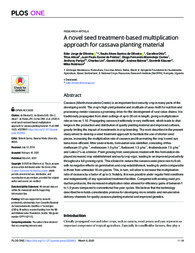A novel seed treatment-based multiplication approach for cassava planting material.
A novel seed treatment-based multiplication approach for cassava planting material.
Author(s): OLIVEIRA, E. J. de; OLIVEIRA, S. A. S. de; OTTO, C.; ALICAI, T.; FREITAS, J. P. X. de; CORTES, D. F. M.; PARIYO, A.; LIRI, C.; ADIGA, G.; BALMER, A.; ROBINSON, M.
Summary: Cassava (Manihot esculenta Crantz) is an important food security crop in many parts of the developing world. The crop?s high yield potential and multitude of uses?both for nutrition and processing?render cassava a promising driver for the development of rural value chains. It is traditionally propagated from stem cuttings of up to 30 cm in length, giving a multiplication rate as low as 1:10. Propagating cassava traditionally is very inefficient, which leads to challenges in the production and distribution of quality planting material and improved cultivars, greatly limiting the impact of investments in crop breeding. The work described in the present study aimed to develop a seed treatment approach to facilitate the use of shorter seed pieces, increasing the multiplication rate of cassava and thus making the crop?s seed systems more efficient. After several tests, formulation was identified, consisting of thiamethoxam 21 g ha-1, mefenoxam 1.0 g ha-1, fludioxonil 1.3 g ha-1, thiabendazole 7.5 g ha-1 and Latex 2% as a binder. Plant growing from seed pieces treated with this formulation displayed increased crop establishment and early crop vigor, leading to an improved productivity throughout a full growing cycle. This allowed to reduce the cassava seed piece size to 8 cm with no negative effects on germination and crop establishment, leading to yields comparable to those from untreated 16 cm pieces. This, in turn, will allow to increase the multiplication ratio of cassava by a factor of up to 3. Notably, this was possible under regular field conditions and independently of any specialised treatment facilities. Compared with existing seed production protocols, the increased multiplication rates allowed for efficiency gains of between 1 to 1.9 years compared to conventional five-year cycles. We believe that the technology described here holds considerable promise for developing more reliable and remunerative delivery channels for quality cassava planting material and improved genetics.
Publication year: 2020
Types of publication: Journal article
Unit: Embrapa Cassava & Fruits
Observation
Some of Embrapa's publications are published as ePub files. To read them, use or download one of the following free software options to your computer or mobile device. Android: Google Play Books; IOS: iBooks; Windows and Linux: Calibre.
Access other publications
Access the Agricultural Research Database (BDPA) to consult Embrapa's full library collection and records.
Visit Embrapa Bookstore to purchase books and other publications sold by Embrapa.

